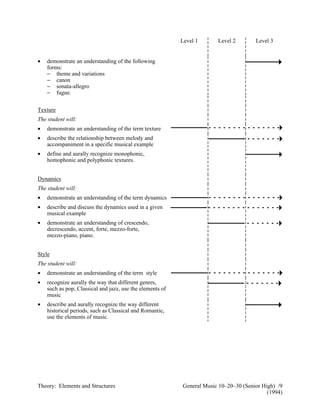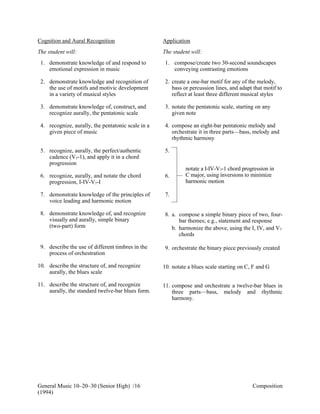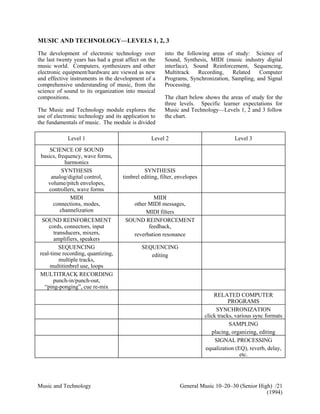The document provides an overview and rationale for Alberta's General Music 10-20-30 program for senior high school students. The program offers a broad range of musical experiences within a non-performance environment. It includes both required and elective components across three levels (10, 20, 30). The required components are Theory: Elements and Structures and Music Making. Elective components include Composition, History of Western Music, Music and Technology, World Music, and others. Modules can be completed in various sequences based on student and teacher preferences. The program aims to develop musical skills and understanding while fostering positive attitudes towards music.
















![Composition General Music 10–20–30 (Senior High) /17
(1994)
Level 2
Ear Training
The student will:
• recognize, aurally, the following intervals:
− unison, perfect fourth, perfect fifth, octave (review)
− major and minor seconds
− major and minor thirds
− major and minor sixths
− major and minor sevenths
• recognize, aurally, major and minor triads
• listen to and notate a one-bar rhythm involving half, dotted half, quarter, dotted quarter, eighth and
triplet eighth notes, and rests in 4
4 and 3
4 time
• listen to and notate a melodic passage of two bars in length, based upon the interval and time values
required in Composition Level 1, and in the intervals, triads and rhythms indicated above.
Cognition and Aural Recognition Application
The student will: The student will:
1. recognize and construct the II and VI chords
in a major key
1. [not applicable]
2. demonstrate knowledge of and aurally
recognize the imperfect half cadence (I-V),
plagal cadence (IV-1) and deceptive cadence
(V7-VI)
2. create chord progressions incorporating
imperfect, plagal and deceptive cadences,
using minimal harmonic motion
3. develop an awareness of the concept of
transposing instruments
3. identify those instruments that sound at concert
pitch and those that require transposition
4. describe the structure and aurally recognize
simple canonic forms
4. compose a short round
5. describe the structure and aurally recognize
simple ternary forms; e.g., ABA form.
5. compose, harmonize in four parts, and
orchestrate a piece in simple ternary form.
Composition Enrichment (Optional)
Composition Level 2 Enrichment Expectations
Cognition and Aural Recognition Application
The student will: The student will:
1. identify all transposing instruments in the
orchestra and explain the correct transposition
for each.
1. rewrite a short melody for a transposing
instrument so it will sound at the pitch of the
original melody.](https://image.slidesharecdn.com/exampleofobjectives-130702071600-phpapp01/85/Example-of-objectives-in-Music-LP-17-320.jpg)
![General Music 10–20–30 (Senior High) /18 Composition
(1994)
Level 3
Ear Training
The student will:
• recognize, aurally, all intervals within an octave, such as diminished and augmented fourths and
fifths
• recognize, aurally, dominant seventh chords, diminished and augmented triads, and diminished
seventh chords
• transcribe a two-bar rhythm involving half, dotted half, quarter, dotted quarter, eighth, dotted eighth,
triplet eighth and sixteenth notes, and rests in 4
4 and 3
4 time
• transcribe a four-bar melodic passage, based upon the interval and time values indicated above.
Cognition and Aural Recognition Application
The student will: The student will:
1. demonstrate knowledge of and recognize the
various nonchord tones used in music, such as
passing tones, grace notes and turns
1. [not applicable]
2. describe and construct dorian and lydian
modes, beginning on notes C, D and F
2. create short (four–eight measure) melodies in
both the dorian and lydian modes
3. demonstrate knowledge of, and recognize
many of the ways in which, a melody can have
variations, such as rhythmic, harmonic, pitch
alteration, diminution, inversion and
augmentation
3. a. create a short melody, and then create six
variations on that melody
b. compose a theme and variations using the
material from 3. (a)
c. harmonize and orchestrate the theme and
variations composed in 3. (b)
4. demonstrate knowledge of and recognize the
various components of song form, such as
introduction, verse, chorus and bridge
4. create a song of at least two verses, with
chorus, introduction and instrumental and/or
vocal bridge. Lyrics may be original or
derived from another source, keeping
copyrights in mind
5. recognize, aurally, and describe various
extended ternary forms, such as minuet and
trio, sonatina, sonata and sonata-allegro.
5. compose a piece in an extended ternary form.](https://image.slidesharecdn.com/exampleofobjectives-130702071600-phpapp01/85/Example-of-objectives-in-Music-LP-18-320.jpg)




















